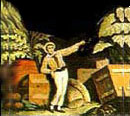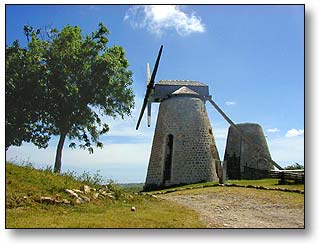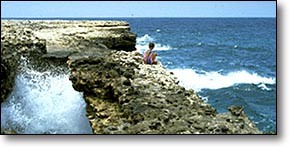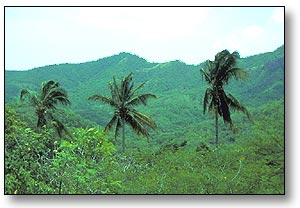| HOME |
| HISTORY, ARTS AND CULTURE |
 |
Back to Exploring Antigua and Barbuda | Photo Album Betty's Hope Sugar Plantation Betty's Hope was the first large sugar plantation on Antigua, and its success led to the island's rapid development of large-scale sugar production. Although the only surviving structures are two stone sugar mills and the remains of the stillhouse, the site's importance in Antiguan history has prompted the government to begin developing it as an open air museum. About a hundred stone windmill towers dot the Antiguan landscape, and the two restored examples at Betty's Hope provide a dramatic sense of the way these mills must have dominated the island during the hundreds of years that sugar production was the dominant industry. Betty's Hope was built by Sir Christopher Codrington, who came to Antigua in 1674 from Barbados, and was named for his daughter.
Indian Town National Park Indian Town Point, on the eastern extremity of the island, is thought to have been an Arawak campsite prior to the arrival of European colonists. Devil's Bridge, a large, natural limestone arch on the shoreline of Indian Town Point, offers one of the most spectacular sights on the island. At high tide, the rougher waves of the Atlantic force enormous geysers of water through boreholes in the rocks near the bridge. Guided tours of the site are available. Fort James Built in the first half of the 18th century, this picturesque bastion was intended to guard the harbour of St. John's. The walls remain in excellent condition, and a few of the cannons are still intact - but the main attraction today is the excellent view of the surrounding harbour. Nearby is Heritage Quay, which comprises a hotel, four duty-free shops, restaurants and a casino, all part of the newest development in downtown St John's. Fig Tree Drive Antigua's most picturesque drive meanders from the low central plain of the island up into the ancient volcanic hills of the Parish of Saint Mary in the island's southwest quarter. The none-too-smooth road passes through an area of lush vegetation and rainforest and rises to the steep farmlands around Fig Tree Hill (figs are what Antiguans call bananas) before descending to the coastline again. Along the way are banana, mango, and coconut groves, as well as a number of old sugar mills and pleasant little churches. Nelson's DockyardAlthough St. John's has long been Antigua's capital city, the island's historic heart is across the island at English Harbour. One of the finest natural harbours in the Caribbean, and located at a highly strategic position, English Harbour was used by Admirals Nelson, Rodney and Hood as a secure home for the British Navy during the Napoleonic wars. Today, Nelson's Dockyard forms part of a designated national park, complete with a museum. shops, hotels, restaurants and a yacht haven. The park embraces the whole of English Harbour and Shirley Heights. Green Castle HillThe 'megaliths' that initially drew curious visitors to Green Castle Hill are almost certainly geologic features, but they are no less impressive and picturesque for being natural features. Green Castle Hill also provides an excellent view of the island's interior, including both the southwestern volcanic mass (of which it is a part) and the interior plain. (due south of St. John's, btw. Jennings and Emanuel).
Click here to see what visitors are saying about the interesting places in Antigua and Barbuda. Back to Exploring Antigua and Barbuda | Photo Album This page, and all contents of this Web site are Copyright (c) 1996-2010 by interKnowledge Corp., New York, NY. All rights reserved. |
|




